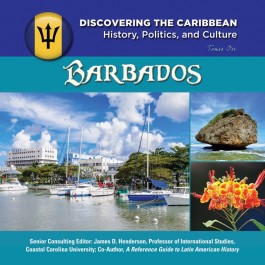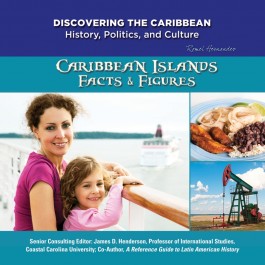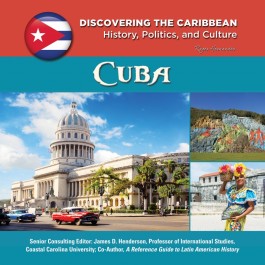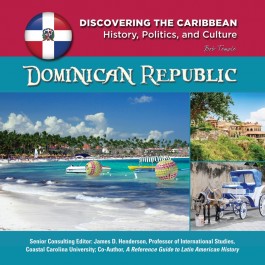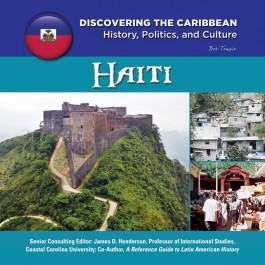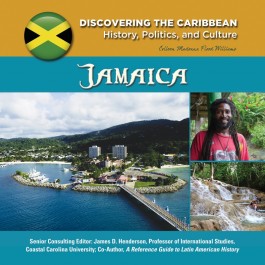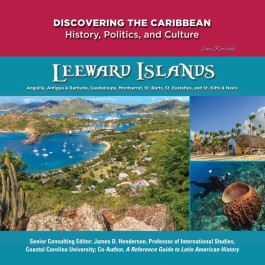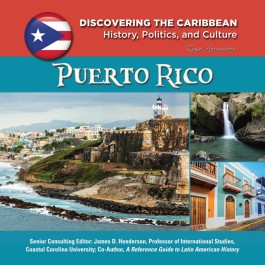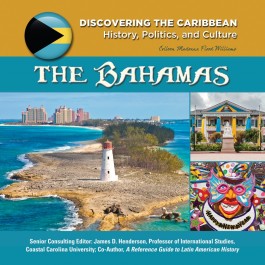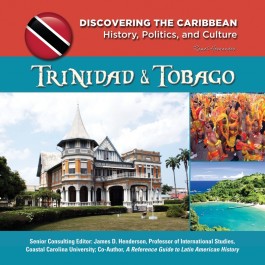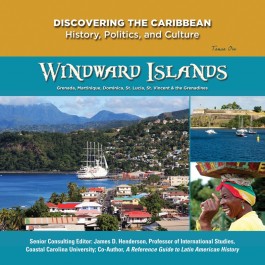DISCOVERING THE CARIBBEAN: HISTORY, POLITICS, AND CULTURE

11
2016
12+
7th - 12th
8 x 8
by Tamra Orr
| Hardcover | ISBN 978-1-4222-3308-5 | $22.95 | Add To Cart |
| eBook | ISBN 978-1-4222-8625-8 | $28.95 | Add To Cart |
Barbados is a small, pear-shaped island, located about 250 miles (400 km) off the coast of South America. In the early 16th century, Portuguese and Spanish explorers often raided the island, capturing and enslaving the natives. By 1627, when the English established a colony on Barbados, the island was practically uninhabited. But the English colony thrived, and Barbados soon became known for its exports of sugarcane. Today, most of Barbados's 280,000 residents are descended from African slaves brought to the island to work on sugarcane plantations. The island gained independence from Great Britain in 1966. It has long been a popular destination for tourists, and each year more than a million visitors delight in the island's lush vegetation, stunning coral reefs, and sandy beaches. There's a lot to discover about
Barbados!
by Romel Hernandez
| Hardcover | ISBN 978-1-4222-3309-2 | $22.95 | Add To Cart |
| eBook | ISBN 978-1-4222-8626-5 | $28.95 | Add To Cart |
Thousands of islands, large and small, are scattered throughout the warm waters of the Caribbean Sea. The largest of these islands are Cuba, Jamaica, Hispaniola (shared by Haiti and the Dominican Republic), and Puerto Rico; together, they are known as the Greater Antilles. Smaller islands include Barbados and Dominica; groups of islands include the Bahamas, the British and U.S. Virgin Islands, and the Leeward and Windward Islands. Approximately 42 million people live in the Caribbean. The culture of the region is a fascinating blend of native, European, and African influences that can vary widely from island to island. Readers of this book are invited to discover the countries of the Caribbean: their history, natural features, economies, people and cultures, and important cities. There's a lot to discover about the
Caribbean!
by Roger Hernandez
| Hardcover | ISBN 978-1-4222-3310-8 | $22.95 | Add To Cart |
| eBook | ISBN 978-1-4222-8627-2 | $28.95 | Add To Cart |
Cuba is the largest island in the Caribbean, and is located 93 miles (150 km) south of Florida. On landing here in 1492, Christopher Columbus called Cuba “The most beautiful land ever beheld by human eyes.” This description still rings true today, as the island is known for its green countryside, majestic palms, and white sand beaches. In major cities like Havana, Santiago de Cuba, and Camagüey, magnificent churches and forts from the Spanish colonial era stand next to modern buildings. Sadly, life has not been so idyllic for the current generation of Cubans, as their island has been ruled by a series of dictators for most of the time since Cuba gained independence in 1902. Since the late 1950s, Cuba has been a Communist state, ruled by Fidel Castro (1959–2008) and his brother Raúl (since 2008). This has led to decades of strained relations with the United States, although Cuba has continued to take a leadership role among the countries of the Caribbean. There's a lot to
discover about Cuba!
by Bob Temple
| Hardcover | ISBN 978-1-4222-3311-5 | $22.95 | Add To Cart |
| eBook | ISBN 978-1-4222-8628-9 | $28.95 | Add To Cart |
In 1492, explorer Christopher Columbus set foot on a large island in the Caribbean Sea that he called Hispaniola. Four years later, his brother Bartholomew founded the New World's first permanent European settlement there. Now called Santo Domingo, the busy port serves as the capital city of the Dominican Republic, a beautiful land that is home to more than 10 million people today. The Dominican Republic covers the eastern two-thirds of the island of Hispaniola, which is located about 575 miles (925 kilometers) southeast of Florida. It is one of the Caribbean's most geographically diverse countries, containing the region's highest mountain peak, largest lake, and lowest elevation. Export crops like sugar and coffee are grown in fertile valleys. The beautiful scenery, including white-sand beaches and cascading waterfalls, attracts more than 4 million foreign visitors each year, making it the Caribbean's most popular tourist destination. There's a lot to discover about the Dominican
Republic!
by Bob Temple
| Hardcover | ISBN 978-1-4222-3312-2 | $22.95 | Add To Cart |
| eBook | ISBN 978-1-4222-8629-6 | $28.95 | Add To Cart |
Named for an Amerindian word meaning “high ground,” the mountainous country of Haiti is the second-oldest independent nation in the Western Hemisphere (surpassed only by the United States). African slaves established the nation in 1804, after an uprising against the colony's French government. Located on the western third of the island of Hispaniola in the Caribbean Sea, Haiti is one of the world's poorest countries, as most of its 10.4 million inhabitants depend upon farming to feed themselves. This has resulted in an environmental crisis, as decades of clearing forests to uncover new farmland has led to widespread soil erosion, which in turn causes destructive flooding throughout the country. The government has been unable to manage Haiti's resources, and periodic political unrest continues to contribute to the country's troubles. There's a lot to discover about
Haiti!
by Colleen Madonna Flood Williams
| Hardcover | ISBN 978-1-4222-3313-9 | $22.95 | Add To Cart |
| eBook | ISBN 978-1-4222-8630-2 | $28.95 | Add To Cart |
Jamaica, the third-largest island in the Caribbean, is located about 580 miles (933 km) south of Florida. Christopher Columbus landed on the island in 1494 and claimed it for Spain. However, Jamaica became a British colony in 1665 and remained under British rule for nearly 300 years. Today, the island has a population of more than 2.8 million, making it the third-largest English speaking country in the Americas after the United States and Canada. Jamaica is a beautiful island that each year draws millions of tourists to its tropical forests, colonial-era cities, and warm, sandy beaches. The island is also known for exports of its natural resources, from sugar, coffee, and bananas to bauxite, a mineral needed to make aluminum. Jamaican musical styles such as reggae and ska, which have become internationally popular, are a major cultural export. There's a lot to discover about
Jamaica!
by Lisa Kozleski
| Hardcover | ISBN 978-1-4222-3314-6 | $22.95 | Add To Cart |
| eBook | ISBN 978-1-4222-8631-9 | $28.95 | Add To Cart |
Located in the eastern Caribbean Sea, the Leeward Islands extend from Puerto Rico to the Windward Islands, forming part of the Lesser Antilles chain. Residents and tourists alike bask in the island's warm trade winds and year-round sunshine. Tropical rain forests, dazzling coral reefs, and white, gold, or pink sand beaches attract visitors from around the world. Two independent countries, Antigua and Barbuda, and St. Kitts and Nevis, are among the 15 islands that make up the Leeward Islands. Other well-known tourist sites include the British dependencies Anguilla and Montserrat, and islands governed by the Netherlands (St. Eustatius, Saba, and Sint Maarten) and France (Guadeloupe). The many popular tourist resorts on these islands play a critical role in their economy, as do banking and fishing. There's a lot to discover about the Leeward
Islands!
by Romel Hernandez
| Hardcover | ISBN 978-1-4222-3315-3 | $22.95 | Add To Cart |
| eBook | ISBN 978-1-4222-8632-6 | $28.95 | Add To Cart |
When he landed on a small Caribbean island in 1493, Christopher Columbus referred to it as puerto rico (Spanish for “rich port”). Today, the name Puerto Rico refers to an archipelago that includes the main island (Puerto Rico) as well as several smaller islands (including Vieques and Culebra). Puerto Rico is the fourth-largest island in the Caribbean, lying approximately 1,000 miles (1,600 km) southeast of Florida. Puerto Rico was a Spanish colony for more than 400 years, before coming under U.S. control in the treaty that ended the 1898 Spanish-American War. Since 1952, Puerto Rico has been a self-governing commonwealth of the United States, and at some point it may become a U.S. state. While tourism is important to the island's economy, unlike many other Caribbean islands Puerto Rico has a solid manufacturing sector, producing pharmaceuticals and electronics among other goods. This has enabled Puerto Ricans to achieve a standard of living that is among the highest in Latin
America. There's a lot to discover about Puerto Rico!
by Colleen Madonna Flood Williams
| Hardcover | ISBN 978-1-4222-3316-0 | $22.95 | Add To Cart |
| eBook | ISBN 978-1-4222-8633-3 | $28.95 | Add To Cart |
The Bahamas is the name for a group of more than 700 islands, cays, and islets located about 50 miles (80 km) off the eastern coast of Florida. The Bahamas extend in a chain stretching southeastward more than 500 miles (800 km). However, only about 20 of these islands are inhabited, with 70 percent of the country's 320,000 residents living on New Providence, where the capital, Nassau, is located. Another 17 percent of the population lives on Grand Bahama, the island closest to the United States. Famous for its mild climate, coral reefs, and spectacular beaches, the Bahamas attracts millions of visitors each year from around the world. For centuries the islands were part of the British Empire, but gained independence in 1973. Today, the Bahamas enjoys great prosperity as a popular tourist destination and international finance center. There's a lot to discover about the
Bahamas!
by Romel Hernandez
| Hardcover | ISBN 978-1-4222-3317-7 | $22.95 | Add To Cart |
| eBook | ISBN 978-1-4222-8634-0 | $28.95 | Add To Cart |
The country of Trinidad and Tobago consists of two large islands and several smaller landmasses in the Caribbean Sea, off the northeast coast of South America. Once a British colony, today Trinidad and Tobago is among the most prosperous and developed of the Caribbean nations. Many international companies have established factories or facilities on the island, and it is a leading producer of oil and natural gas. The two main islands that give the country its name are very different. Trinidad, the larger island, is densely populated. It is home to steel mills, oil fields, factories, livestock farms, and sugarcane estates, and has become a regional financial center. The mountainous island of Tobago, on the other hand, is far less developed. Located about 20 miles (32 kilometers) to the northeast of Trinidad, Tobago's economy depends heavily on tourism. There's a lot to discover about Trinidad and
Tobago!
by Tamra Orr
| Hardcover | ISBN 978-1-4222-3318-4 | $22.95 | Add To Cart |
| eBook | ISBN 978-1-4222-8635-7 | $28.95 | Add To Cart |
The Windward Islands are a group of islands that stretch for more than 300 miles (483 km) around the southeastern end of the Caribbean Sea. This island group includes four independent countries: Dominica, St. Lucia, Grenada, and St. Vincent and the Grenadines. It also includes Martinique, an island governed by France. During the early 1600s, Europeans in sailing vessels arrived in the Windward Islands. (The name “Windward Islands” refers to the direction of prevailing winds encountered by ships sailing from Europe.) These Europeans eventually killed or enslaved the indigenous people they found there and established colonies to exploit the island's resources. Dominica, St. Lucia, Grenada, and St. Vincent and the Grenadines were British colonies until they gained independence during the 1970s; Martinique remains an overseas department of France. Today the Windward Islands are best known for their modern resort communities and warm, sunny beaches. There's a lot to discover about the
Windward Islands!











